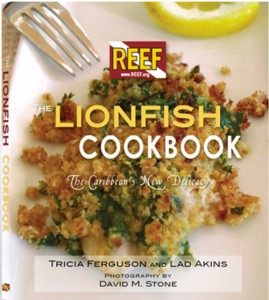No enemies and 2,000,000 eggs
Wearing an outrageous costume of a Brazilian Mardi Gras reveler, lionfish are sinister creatures hiding behind an exquisite mien. Their rainbow colored and glorious fin rays are venomous. They have no known natural enemy; they can live in excess of 15 years; eat almost any reef species including crustaceans up to half their size and can grow to the size of a football. A coral reef populated by lionfish can consume 500,000 fish an acre a year and studies have shown that lionfish could be decreasing Atlantic reef diversity by up to 80%. During a year, a female will spawn 2 million eggs.
Eating the reef
Imported in the 1980s from the Indo-Pacific (two of nine known species) as tropical aquatic pets; many were released into Florida’s tropical waters during Hurricane Andrew in 1992. The carnivores quickly became more than just another reef dweller in good standing. They ate the reef and moved to the next one. They now range from North Carolina to the Caribbean and more recently were found inhabiting Flower Garden Banks National Marine Sanctuary off the coast of Louisiana.
Impact
Long term, the lionfish will likely impact prey population numbers and directly affect food web relationships.
Ouch!
The venom of the lionfish, delivered via an array of up to 18 needle-like dorsal fins, is purely defensive. It relies on camouflage and lightning-fast reflexes to capture prey, mainly fish and shrimp. A sting from a lionfish is extremely painful to humans and can cause nausea and breathing difficulties, but is rarely fatal.
Ceviche anyone?

Help a reef, eat a lionfish – click here to order you copy and thanks for helping protect our reefs
The Reef Environmental Education Foundation, Key Largo, Florida sponsors a round-up derby with cash prizes for catching the most, smallest and largest lionfish and they have a cookbook (see cover on previous page) designed to educate restaurant chefs on how they can incorporate lionfish into their menu.
Many recipes for lionfish can be found in other coastal cookbooks with how to safely handle them and how to serve-up fried lionfish, lionfish ceviche, lionfish jerky and grilled lionfish.
Tastes like grouper
In the Florida Keys, Bahamas and in some Miami restaurants, lionfish is offered as an appetizer or entree or both. It’s similar in taste and consistency to grouper – delicious.
[information]
SIDEBAR: Menu item that’s popular at the Bimini Big Game Club Resort and Marina, Bimini, Bahamas. BBGC began serving Panko fried lionfish nuggets a few years ago and thy’re now a guest favorite. Here’s Chef Alvarez Bastian’s recipe.
Ingredients for Panko Breaded Lionfish Nuggets ala Bimini Big Game Club:
4 oz. lionfish, flour, 1 cup liquid egg, Panko breadcrumbs, S & P and Cajun seasoning.
In three separate bowls, place flour, liquid egg and breadcrumbs.
Cut lionfish into bite-size pieces and season with salt, pepper and Cajun seasoning. Dip pieces into flour, shake off excess, then dip into liquid egg, and then into breadcrumbs. Submerge in oil heated to 325 degrees until crispy golden brown.
Cilantro and Key Lime Tarter Sauce:
1 cup mayonnaise, 1 small pickle, diced small, 2 tsp Key Lime juice, 6 leaves cilantro, chopped, 2 tablespoons capers, chopped
Mix the above ingredients in a mixing bowl.
Add salt and pepper to taste. Refrigerate until ready to serve.
[/information]



